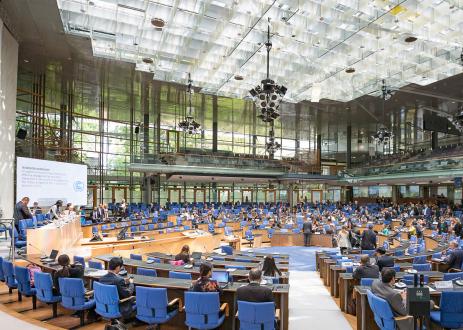Making Finance Consistent with Climate Goals
《 UNFCCC巴黎协定》第2.1C条操作的见解

Synopsis
This paper develops a framework and tools that governments and non-state actors can use to drive action, track progress and increase ambition to operationalize the Paris Agreement’s long-term goal of making finance flows consistent with a pathway towards low greenhouse gas emissions and climate-resilient development.
关键发现
- Article 2.1c is one of the most important parts of the Paris Agreement: aligning finance to support climate action is the means to meeting both the temperature and adaptation goals. It is the first time that the United Nations Framework Convention on Climate Change (UNFCCC) process has set a collective goal reflecting the full scale of effort needed on finance to successfully address climate change. The goal acknowledges a vital piece of the puzzle in tackling climate change, sending a strong signal about the need to look at all finance (both public and private, domestic and international) and ensure it is supportive of, and not undermining, the transition to a low-greenhouse gas emission, climate-resilient world.
- Yet there is limited awareness of, few opportunities for discussion on, and insufficient action to meet the goal. To address these gaps, this paper suggests a three-part framework that highlights the different entry points for governments and other stakeholders to operationalise Article 2.1c: (1) drive action to mobilise and shift finance; (2) track progress against Article 2.1c; and (3) increase ambition.
- Governments, the private sector and civil society all have critical roles to play in driving action, tracking progress and raising ambition. The workload is substantial, and it will be important to further map, coordinate and build on existing initiatives as well as develop new ones to fill the gaps identified.
- As part of highlighting the approaches that can be taken both inside and outside of the UNFCCC, we outline the four key sets of tools that primarily governments can employ to shift finance: financial policies and regulations, fiscal policy levers, public finance and information instruments.
- 该研究建议,《巴黎协定当事方》必须部署他们手头上的所有工具来重新融资,并需要紧急采取行动:2018年IPCC报告发现,要保持温暖到1.5°C,世界需求量使世界需求保持一致。必威官网是真的吗在25年内达到零温室气体排放。更加明显的是,到2030年,排放目前已正常超过1.5°C的“碳预算”。没有时间延迟。
执行摘要
截至2018年11月,巴黎协定的当事方(截至2018年11月)致力于“使金融流量与低温温室气体排放和气候富裕的发展相一致”(第2.1C条)。必威官网是真的吗This commitment represents one of the Agreement’s three long-term goals, with the other two (2.1a and 2.1b) focused on limiting the increase in global average temperatures to well below 2°C, and ideally 1.5°C above pre-industrial levels (Article 2.1a) and increasing the ability to adapt to climate change (Article 2.1b). The three goals are closely connected: realignment of finance is a necessary condition for achieving the temperature and adaptation goals of the Agreement. And there is no time to delay: the recent Intergovernmental Panel on Climate Change (IPCC) report found that to keep warming to 1.5°C the world needs to reach net-zero greenhouse gas emissions within 25 years, and that this will require a ‘major reallocation of the investment portfolio’. More starkly, emissions are currently on track to exceed the ‘carbon budget’ for 1.5°C by 2030.
第2.1c条打破了新的地面。这是联合国气候变化框架公约(UNFCCC)第一次设定了一个集体目标,反映了金融上所需的全部努力以成功解决气候变化。必威官网是真的吗它承认应对气候变化的重要难题,发出了关于需要查看所有金融(公共和私人,国内和国际)的需求的强烈信号,并确保它支持必威官网是真的吗并不会破坏过渡到低的过渡-Greenhouse气体排放,气候富裕世界。必威官网是真的吗
为了履行他们根据巴黎协议的承诺,并从气候兼容投资中获得更广泛的好处,政府和非国家行为者需要确定UNFCCC及其他地区的流程,以操作第2.1C条,并探索一系列工具必威官网是真的吗可用于成本效益管理过渡。为此,本文开发了一个由三部分组成的框架来支持政府(主要是巴黎协定的当事方)和非国家行为者,以确定机遇:(1)推动行动以动员和转移金融的行动;(2)针对第2.1C条的进度;(3)增加野心。
As part of highlighting the approaches that can be taken both inside and outside of the UNFCCC, we also outline the four key sets of tools that primarily governments can employ to shift finance. This toolkit includes: financial policies and regulations; fiscal policy levers; public finance; and information instruments.
Using real-world examples for each, we look at how these tools are currently being used to drive action and how they are included in existing processes to track progress, and at the focus of efforts to raise ambition towards Article 2.1c. To limit the scope of this toolkit, we focus on financial policies and regulations linked to the finance specific goal of Article 2.1c. We have not included an analysis of wider policies and regulations that are key to achieving the mitigation and adaptation objectives of Articles 2.1a and 2.1b, while recognising they are also critical for shaping finance.
最后,我们概述了需要确保UNFCCC流程和链接活动的关键下一步步骤支持国家实现第2.1C条的目标。这些包括:
- 在UNDCCC中 - 澄清和建立了《巴黎协定的规定》和相关的INFCCC程序,以更明确地支持各国可以对第2.1 c条采取的行动。其中包括全球股票,全国确定的贡献(NDC)和增强的透明度框架。鉴于巴黎协议下的全国决心承诺的性质,各国可以自愿将第2.1C条纳入其努力中
- 除了UNFCCC之外,在第2.1C条及其含义和机遇之外,动员了UNFCCC(包括公共财政机构,投资者和商业团体等)以外的主要参与者;跟进现有的举措,以确保这些团体履行其现有承诺,并做出新的巴黎,雄心勃勃的雄心勃勃的承诺,以针对金融市场的主流;而且,在近期中,与联合国秘书长的2019年气候峰会及其联系的气候财务领导力倡议(CFLI)互动。必威官网是真的吗


Projects
-

International Climate Finance
Visit Project我们的国际气候金融工作加强了重要的国必威官网是真的吗际机构中的关键政策和治理要素,以促进巴黎在金融方面的协议一致,并维护气候金融在国际谈判中的作用。必威官网亚洲体育
部分 Finance
